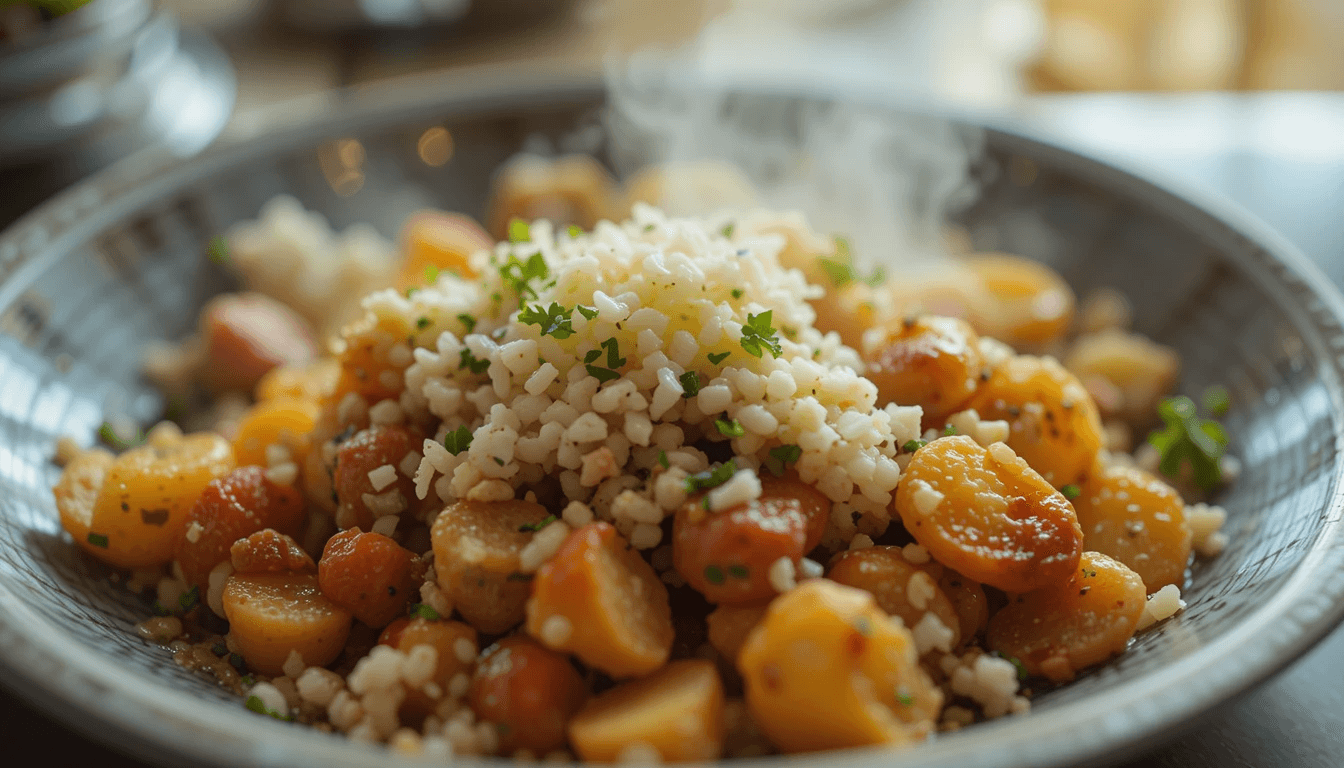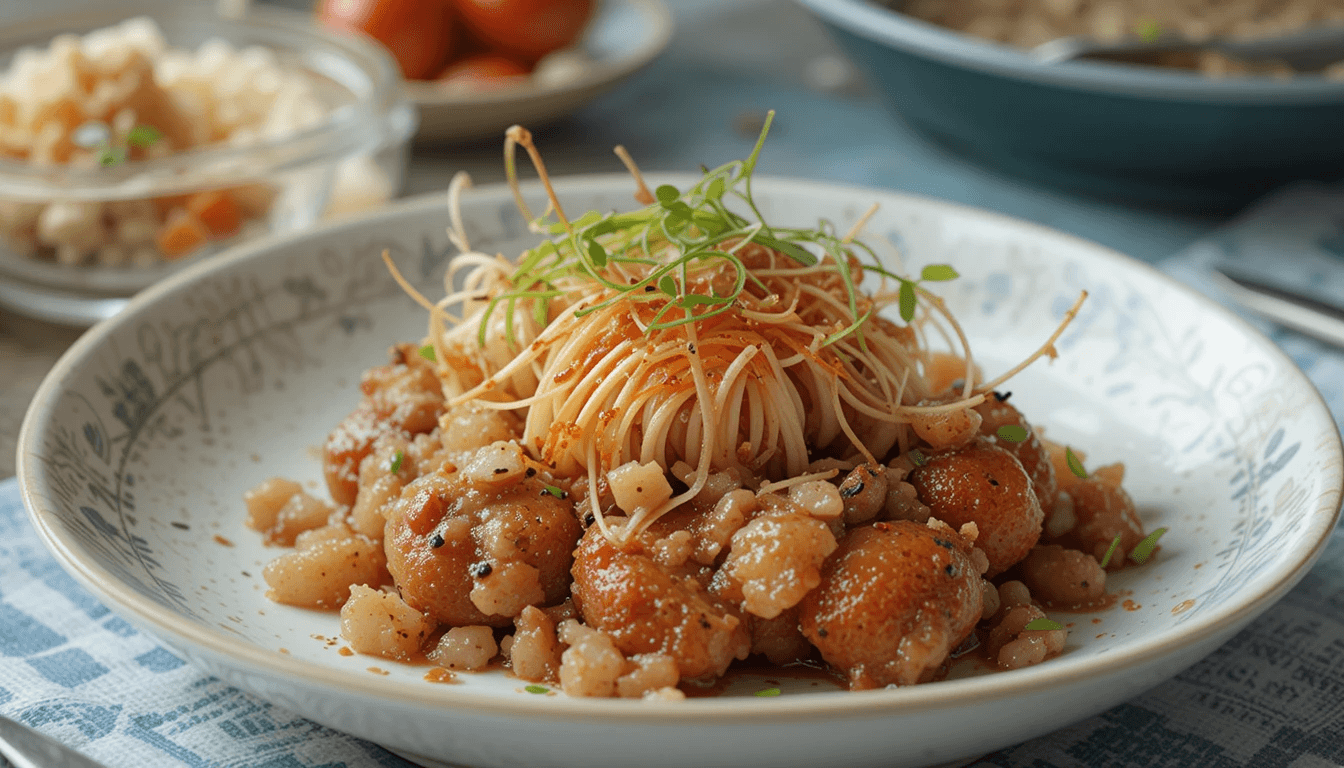
rising recipes give you the power to craft irresistibly fluffy dishes with minimal effort. By focusing on dough expansion, fermentation, or leavening agents, these recipes offer delightfully airy textures and unforgettable flavors. Whether you’re aiming for savory dinner staples or sweet desserts, rising recipes bring joy to any meal.
Introduction
Have you ever felt an extra burst of excitement when watching dough rise in your kitchen—like witnessing a small miracle unfolding before your eyes? There’s something undeniably satisfying about seeing a simple mixture of ingredients transform into a golden, puffy creation, all thanks to the magic that happens behind the scenes.
But rising recipes aren’t just about bread dough fluffing up in the oven. They also include ingenious cooking methods, yeast-based wonders, and even specialized batters that produce airy and tender results.
Beyond the fluff factor, rising recipes can become a gateway to countless creative spins on your favorite meals, tapping into your playful side while putting dinner on the table.

Understanding the Allure of Rising Recipes
rising recipes are often associated with bread-baking, but the term can apply to any dish that leverages yeast, chemical leavening, or other methods to expand the batter or dough.
The allure comes from that magical moment when you see the volume of your mixture nearly double (or even triple!). Let’s explore some reasons why these recipes captivate everyone from first-time cooks to professional chefs.
- Visual Transformation
- Watching a dough or batter inflate is mesmerizing.
- It signals that the leavening action—be it yeast, baking powder, or steam—works its magic.
- This transformation in rising recipes often generates the wow-factor that turns a simple meal into an event.
- Texture Delight
- Fluffiness or lightness in a dish feels like a reward for your patience.
- Whether you bite into a pillowy dinner roll or an airy dessert, the texture elevates the taste experience.
- rising recipes inherently deliver that tender crumb or soft interior that people crave.
- Flavor Enhancement
- Yeast-based rising recipes, in particular, develop complex flavor profiles due to fermentation.
- Slow-risen dough can carry subtle sweet or tangy notes that deepen the taste.
- Even quick-rising batters take on nuanced flavors when the right ingredients complement the leavening process.
- Community & Tradition
- Many cultures celebrate special occasions with rising recipes like challah, brioche, or traditional festive breads.
- Passing down bread-making techniques from generation to generation is a way families keep culinary traditions alive.
- Because of their universal appeal, rising recipes often foster connection among people sharing meals.
- Infinite Adaptations
- Once you grasp the basics, you can customize rising recipes with your favorite herbs, cheeses, fruits, or spices.
- The dough or batter basically acts as a blank canvas waiting for your creative spin.
- This flexibility means you’ll always have new rising recipes to try without feeling stuck in a culinary rut.
The Science Behind rising recipes
You may be wondering, “How does something go from a dense lump of flour and water to a puffy, structured masterpiece?” The answer lies in a bit of science—mainly gas expansion and gluten development.
Yeast Fermentation
Yeast is a living microorganism that consumes sugars in the dough and produces carbon dioxide (CO₂) and ethanol. The CO₂ gas gets trapped in the gluten network (formed when wheat flour proteins link together), causing the dough to expand. That’s why kneading is so critical: it helps develop the gluten strands that hold the gas bubbles in place. Longer rising times often lead to more complex flavors as the fermentation process continues.
Chemical Leavening
Baking powder and baking soda do not rely on living organisms. Instead, they create gas bubbles when reacting with acidic components and moisture in the batter. This is typical of quick breads, cakes, pancakes, and other rising recipes that don’t require a rising rest time. The reaction happens rapidly—hence the name “quick breads”—and you’ll see results right in the oven or stove.
Steam and Expansion
Some recipes rely on water vapor. For instance, pâte à choux (used for cream puffs) uses steam generated by high oven heat to create hollow, airy centers. Steam can also aid the rise in doughs that already have yeast or chemical leavening, boosting that fluffy finish.
Gluten-Free Rising
Worried you can’t enjoy rising recipes if you’re gluten-sensitive or have celiac disease? Today, there are gluten-free flour blends specifically designed with alternative binders like xanthan gum. These help mimic gluten’s stretch and elasticity. While results may differ slightly from traditional wheat flour versions, you can still create fantastic rising recipes that cater to dietary needs.
Expert reference: According to the U.S. Department of Agriculture (USDA) guidelines, proper handling and preparation of any dough or batter—including controlling temperature and preventing cross-contamination—are essential steps to ensure safe, enjoyable meals.
Key Ingredients for Successful rising recipes
No matter which approach you choose—yeast, chemical leavening, or steam—pay attention to a few vital components that can make or break your rising recipes:
- Quality Flour
- Different types of flour (bread flour, all-purpose, pastry, etc.) contain varying protein levels.
- Bread flour has more protein, which typically supports stronger gluten development, perfect for lofty loaves.
- For delicate cakes or pastries, lower protein flours help you achieve that tender, melt-in-your-mouth crumb.
- Leavening Agent
- Fresh yeast or active dry yeast for yeast-based rising recipes.
- Baking powder or baking soda (with an acidic ingredient like yogurt or lemon juice) for quick breads.
- Properly store these agents to ensure they remain potent.
- Liquid & Temperature
- Water or milk hydrates the flour and activates yeast in yeast-based rising recipes.
- Temperature matters: water that’s too hot kills yeast, while overly cold water slows fermentation.
- Follow the recipe’s instructions on liquid temperatures for the best results.
- Fat
- Butter, oil, or other fats add moisture, flavor, and can tenderize the gluten network.
- In yeast doughs, a bit of fat can also slow rising, which may deepen flavor.
- For quick breads, the choice of fat affects taste and texture (butter for richness, oil for moistness).
- Sweeteners
- Sugar, honey, or other sweeteners feed yeast in yeast doughs, aiding fermentation.
- In quick breads, sugar not only sweetens but can also help with browning.
- Balancing sweetness is crucial in savory rising recipes to avoid clashing flavors.
- Add-ins
- Herbs, seeds, cheese, fruits, nuts—all can enhance the complexity of rising recipes.
- Add them at the right stage: too early can interfere with gluten formation, too late might disrupt shaping.
- Many recipes specify the exact timing to incorporate these flavorful extras.
Categories of Delicious rising recipes
It’s easy to think primarily of bread when you hear “rising recipes,” but these dishes come in countless forms. Below, we’ll explore a few broad categories you can dive into.
1. Classic Yeast Breads
- Sandwich Loaves: Soft, sliceable bread for everyday use.
- Sourdough: Uses a natural starter with wild yeast and bacteria for tangy depth.
- Artisan Breads: Crusty, rustic loaves like ciabatta or French baguettes.
- Enriched Breads: Tender brioche or challah, elevated by eggs, milk, and butter.
2. Sweet Pastries
- Cinnamon Rolls: Swirls of sweet dough layered with sugar and spice, topped with icing.
- Donuts: Yeast-risen donuts have a lighter texture than cake versions.
- Breakfast Danishes: Flaky pastry typically filled with fruit or cheese.
- Enriched Dough Desserts: Braided sweet loaves or tear-apart rolls for special occasions.
3. Quick Breads & Muffins
- Banana Bread: Classic crowd-pleaser that relies on baking soda or baking powder.
- Zucchini Bread: Incorporates shredded veggies, making it moist and tender.
- Chocolate Chip Muffins: Light, airy muffins that pop out of the tin in fluffy mounds.
- Cornbread: A staple in many Southern kitchens, using chemical leavening for its rise.
4. Savory Bakes
- Pizza Dough: Yeast-based dough that puffs up around the edges.
- Focaccia: Italian flatbread famed for its light, airy crumb and olive oil richness.
- Dinner Rolls: Versatile side for soups, stews, and holiday meals.
- Stromboli or Calzones: Folded or rolled dough stuffed with savory fillings.
5. Specialty & Global Favorites
- Bao Buns: Steamed buns from Chinese cuisine, known for their pillowy texture.
- Naan or Pita: Yeast flatbreads that puff into airy pockets over high heat.
- Pretzels: A quick dip in a baking soda bath helps them develop that iconic chewy crust.
- Bagels: Boiled then baked for a dense, delicious chew that rises just enough.
6. Desserts That Rely on Expansion
- Soufflés: Whipped egg whites give them their signature towering rise.
- Angel Food Cake: Light as air due to beaten egg whites and gentle folding.
- Chiffon Cakes: Combines egg-white foam with chemical leavening for an ultra-soft crumb.
- Cream Puffs & Éclairs: Steam helps pâte à choux rise into hollow shells, ready for sweet fillings.
Tips for Mastering rising recipes
Maybe you’ve tried a few rising recipes and ended up with a doughy brick or a cake that refuses to stand tall. Here are some tips to elevate your success rate:
- Precision Matters
- Baking is a science. Weighing ingredients often yields better results than using volume measurements.
- Even a slight deviation in flour or water can throw off the dough’s consistency.
- Warm, Cozy Environment
- Yeast thrives in warm (but not hot) conditions, typically around 75–85°F (24–29°C).
- If your kitchen is cold, try letting your dough rest in a turned-off oven with the light on.
- Maintaining a cozy environment supports quicker, more consistent rises.
- Knead or Fold Properly
- For yeast doughs, kneading develops the gluten network.
- Over- or under-kneading can compromise the dough’s ability to trap gas.
- Some no-knead bread recipes rely on a long, slow fermentation instead, so read instructions carefully.
- Avoid Overproofing
- Letting dough rise too long can lead to overly large air pockets and a collapsed final product.
- Most rising recipes will specify an optimal rise time or how the dough should look (e.g., “doubled in size”).
- Keep an eye on your dough or batter so you catch it at the perfect stage.
- Handle with Care
- Gently shape risen dough to avoid deflating the air pockets you’ve worked to build.
- For recipes with whipped egg whites, fold them into the batter to avoid losing the air you whipped in.
- The lighter your touch, the fluffier your final treat.
- Monitor Oven Heat
- Preheat the oven for at least 10–15 minutes to ensure it’s at the correct temperature.
- Investing in an oven thermometer can help identify if your oven runs hot or cold.
- Proper heat ensures rising recipes set well and don’t collapse in the middle of baking.
- Experiment & Learn
- Don’t be afraid to try different flours, sweeteners, or additional flavorings.
- Keep notes on what worked and what didn’t to refine your approach.
- Every kitchen is slightly different in temperature, humidity, and equipment, so practice is key.
Rising Recipes for Every Meal of the Day
rising recipes can be your secret weapon for any occasion—from lazy weekend brunches to quick weeknight dinners and even elegant gatherings. Here are some suggestions:
Breakfast Bliss
- Overnight Cinnamon Rolls: Mix the dough at night, let it rise in the fridge, and bake in the morning.
- Yeast Waffles: Incorporate yeast into your waffle batter for extra crispness and airy pockets.
- Breakfast Pizza: Use a well-risen dough to cradle eggs, cheese, and bacon for a morning treat.
Lunch Upgrades
- Soup & Rolls Combo: Pair a hearty vegetable soup with freshly baked dinner rolls or baguettes.
- Sandwich Spread: Slice up a homemade loaf for sandwiches that taste far more special than the store-bought variety.
- Stuffed Calzones: Fill pizza dough with meats, vegetables, and cheese for a portable midday meal.
Dinner Favorites
- Focaccia Feast: Drizzle olive oil, sprinkle sea salt and rosemary, and bake until fluffy and golden.
- Cast-Iron Skillet Bread: A rustic loaf baked in a cast-iron skillet pairs beautifully with stews.
- Enchilada Pie: Layer tortillas or thin dough in a baking dish, letting them soften and rise slightly in tomato sauce and cheese.
Dessert Delights
- Fruit-Filled Pastries: Braid an enriched dough around fresh fruit preserves for a shareable dessert.
- Cream Puffs: Practice your pâte à choux and pipe in sweet custard or whipped cream.
- Bundt Cakes: Light, moist cakes with a bit of rising action from baking powder or soda, made extra festive in a decorative Bundt pan.
How to Adapt rising recipes for Different Diets
In today’s culinary landscape, many home cooks are adapting to gluten-free, dairy-free, or egg-free diets without giving up their favorite rising recipes. Here’s how:
- Gluten-Free Flours
- Look for blends that mimic the protein structure of wheat flour.
- Binders like xanthan gum or psyllium husk powder can support the “rise” in the absence of gluten.
- You might need extra liquid or a longer rise time due to the different absorption properties.
- Dairy Alternatives
- Swap cow’s milk for plant-based options like almond, soy, or oat milk if the recipe calls for milk.
- Nondairy butter or margarine can replicate the role of fat in many doughs and batters.
- Always confirm the substitution ratio is 1:1 (or otherwise specified by the recipe).
- Egg Replacements
- For vegan rising recipes, consider flaxseed or chia seed gels to bind ingredients.
- Aquafaba (the liquid from canned chickpeas) can be whipped like egg whites for some airy desserts.
- Keep in mind these substitutes can slightly alter texture and flavor, so minor tweaks might be needed.
- Lower Sugar Options
- Reduce sugar by replacing it with sweeteners like stevia or erythritol, though not all sweeteners help feed yeast.
- For yeast-based rising recipes, experiment with a small amount of sugar or honey to ensure fermentation.
- Adjust your taste preferences gradually, noting that less sugar might impact browning and texture.
FAQs
What are some dinner menu ideas using rising recipes?
rising recipes can amp up your evening spread with fluffy dinner rolls, savory focaccia, or stuffed calzones. They add comforting textures that pair well with soups, stews, or salads. You can even transform a basic pizza dough into indulgent breadsticks.
How do I find simple rising recipes for beginners?
Start with rising recipes that rely on minimal kneading, like no-knead bread or quick rolls. These dishes highlight simple techniques and yield light, delicious results. Gradually, you can expand to more advanced projects as your confidence builds.
How can chicken be incorporated into rising recipes?
Use rising recipes by encasing seasoned chicken in fluffy dough, like in chicken calzones or pot pies. The bread component locks in moisture for tender, flavorful bites. Layer veggies and cheese to complete the savory ensemble.
Which sweet treats count as rising recipes for dessert?
Cream puffs, cinnamon rolls, and even fluffy bundt cakes all qualify as rising recipes. They rely on steam, yeast, or chemical leavening to achieve airy textures. You’ll love how these desserts taste light yet decadent.
What are quick dinner solutions using rising recipes?
Rapid pizza dough, one-hour dinner rolls, or quick flatbreads are rising recipes perfect for busy nights. They’re fast to prepare and deliver warm, comforting goodness. Keep ingredients on hand for an effortless weeknight meal.
Can I make rising recipes ahead of time for easy planning?
Yes, many rising recipes can be prepped and refrigerated. A slow, cool rise in the fridge enhances flavor and texture. Come mealtime, bake or cook as needed, and enjoy freshly risen goodness.
How do I incorporate whole grains into rising recipes?
Simply swap part of the white flour for whole-wheat or spelt flour in rising recipes. You’ll get extra fiber and a heartier flavor. Adjust liquids slightly if needed to maintain the dough’s moisture balance.
What if my rising recipes don’t puff up as expected?
Check your yeast’s freshness and your kneading technique to ensure proper gluten formation. Also verify dough temperature and rising times. With small tweaks, your rising recipes can achieve the lift you crave.
Key Takeaways
- rising recipes rely on gas expansion via yeast, chemical leavening, or steam for unique textures.
- Watch temperature, timing, and freshness of ingredients for consistent results.
- Experiment with various flours, sweeteners, and dietary adaptations to personalize your rising recipes.
- Practice and note your experiences to master the art of “puff and expand.”
- Enjoy the process—rising recipes bring a magical element to everyday cooking.
Conclusion
There’s a kind of magic in watching rising recipes transform right before your eyes, whether you’re mixing up a comforting loaf of bread, whipping egg whites for a dazzling soufflé, or folding dough around savory fillings. Not only do these recipes create textures that feel extra satisfying to bite into, but they also offer a sense of ritual and joy that comes from working with living or reactive ingredients. By understanding the science, practicing key techniques, and experimenting to match your preferences (or dietary needs), you’ll soon be serving up fluffy, airy dishes that impress friends, family, and even yourself.
